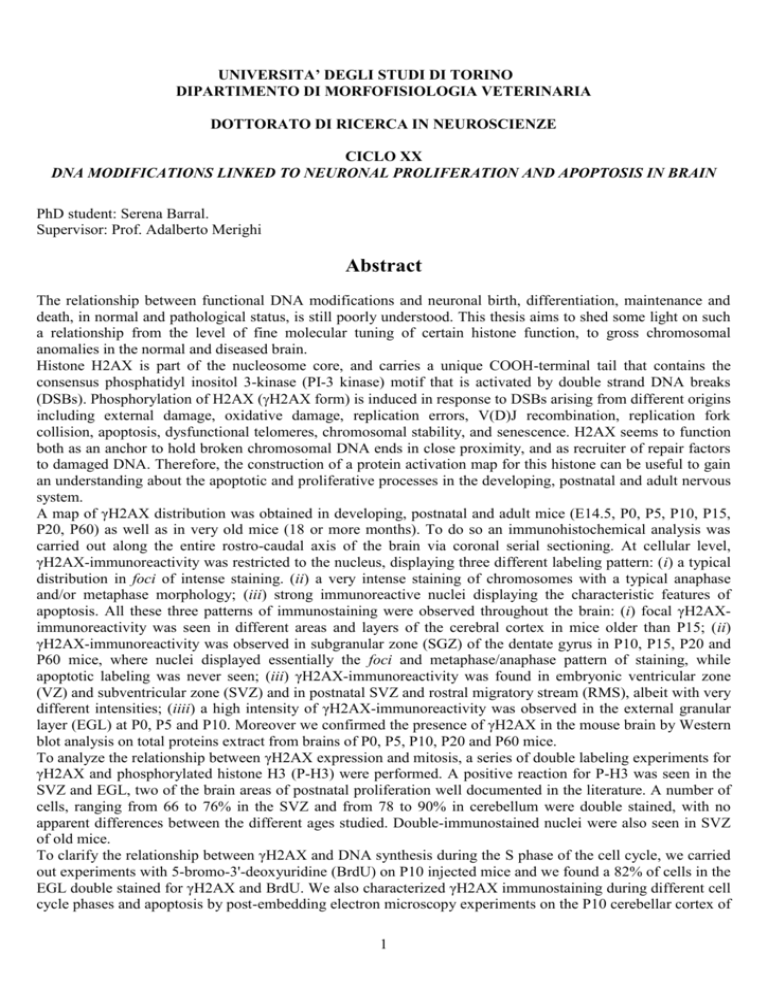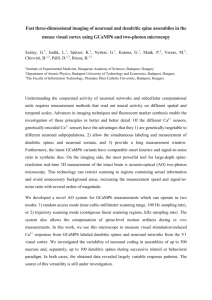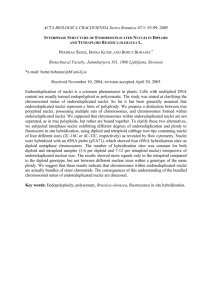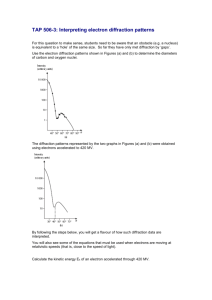universita` degli studi di torino
advertisement

UNIVERSITA’ DEGLI STUDI DI TORINO DIPARTIMENTO DI MORFOFISIOLOGIA VETERINARIA DOTTORATO DI RICERCA IN NEUROSCIENZE CICLO XX DNA MODIFICATIONS LINKED TO NEURONAL PROLIFERATION AND APOPTOSIS IN BRAIN PhD student: Serena Barral. Supervisor: Prof. Adalberto Merighi Abstract The relationship between functional DNA modifications and neuronal birth, differentiation, maintenance and death, in normal and pathological status, is still poorly understood. This thesis aims to shed some light on such a relationship from the level of fine molecular tuning of certain histone function, to gross chromosomal anomalies in the normal and diseased brain. Histone H2AX is part of the nucleosome core, and carries a unique COOH-terminal tail that contains the consensus phosphatidyl inositol 3-kinase (PI-3 kinase) motif that is activated by double strand DNA breaks (DSBs). Phosphorylation of H2AX (H2AX form) is induced in response to DSBs arising from different origins including external damage, oxidative damage, replication errors, V(D)J recombination, replication fork collision, apoptosis, dysfunctional telomeres, chromosomal stability, and senescence. H2AX seems to function both as an anchor to hold broken chromosomal DNA ends in close proximity, and as recruiter of repair factors to damaged DNA. Therefore, the construction of a protein activation map for this histone can be useful to gain an understanding about the apoptotic and proliferative processes in the developing, postnatal and adult nervous system. A map of γH2AX distribution was obtained in developing, postnatal and adult mice (E14.5, P0, P5, P10, P15, P20, P60) as well as in very old mice (18 or more months). To do so an immunohistochemical analysis was carried out along the entire rostro-caudal axis of the brain via coronal serial sectioning. At cellular level, γH2AX-immunoreactivity was restricted to the nucleus, displaying three different labeling pattern: (i) a typical distribution in foci of intense staining. (ii) a very intense staining of chromosomes with a typical anaphase and/or metaphase morphology; (iii) strong immunoreactive nuclei displaying the characteristic features of apoptosis. All these three patterns of immunostaining were observed throughout the brain: (i) focal γH2AXimmunoreactivity was seen in different areas and layers of the cerebral cortex in mice older than P15; (ii) γH2AX-immunoreactivity was observed in subgranular zone (SGZ) of the dentate gyrus in P10, P15, P20 and P60 mice, where nuclei displayed essentially the foci and metaphase/anaphase pattern of staining, while apoptotic labeling was never seen; (iii) γH2AX-immunoreactivity was found in embryonic ventricular zone (VZ) and subventricular zone (SVZ) and in postnatal SVZ and rostral migratory stream (RMS), albeit with very different intensities; (iiii) a high intensity of γH2AX-immunoreactivity was observed in the external granular layer (EGL) at P0, P5 and P10. Moreover we confirmed the presence of γH2AX in the mouse brain by Western blot analysis on total proteins extract from brains of P0, P5, P10, P20 and P60 mice. To analyze the relationship between γH2AX expression and mitosis, a series of double labeling experiments for γH2AX and phosphorylated histone H3 (P-H3) were performed. A positive reaction for P-H3 was seen in the SVZ and EGL, two of the brain areas of postnatal proliferation well documented in the literature. A number of cells, ranging from 66 to 76% in the SVZ and from 78 to 90% in cerebellum were double stained, with no apparent differences between the different ages studied. Double-immunostained nuclei were also seen in SVZ of old mice. To clarify the relationship between γH2AX and DNA synthesis during the S phase of the cell cycle, we carried out experiments with 5-bromo-3'-deoxyuridine (BrdU) on P10 injected mice and we found a 82% of cells in the EGL double stained for γH2AX and BrdU. We also characterized γH2AX immunostaining during different cell cycle phases and apoptosis by post-embedding electron microscopy experiments on the P10 cerebellar cortex of 1 control and BrdU-injected mice, confirming the activation of γH2AX from S phase to M phase of the cell cycle and during first phases of apoptosis. Positive nuclei for γH2AX can be either Neuronal nuclei (NeuN) or glial fibrillary acidic protein (GFAP) positive, in particular in cerebral cortex where cells are differentiated post-mitotic neurons or glia, while in SVZ only GFAP+γH2AX positive cells were found. This study demonstrate the existence of high levels of γH2AX immunoreactivity at different stages of mouse brain development. In rapidly dividing cells, such those of the embryonic and juvenile SVZ and postnatal cerebellar EGL, phosphorylation of H2AX is linked to proliferation and apoptosis. In particular, we demonstrate for the first time the activation of H2AX during S-, G2-, and M phase of cell cycle in vivo, and confirmed the activation of H2AX in the first phases of apoptosis. The existence of high levels of γH2AX immunoreactivity with the typical foci staining in the cerebral cortex is puzzling and can be linked to the well known role of H2AX in DNA repair, particularly in DSBs. In most progressive neurological diseases, the degenerative cell death of neurons lies at the vanguard of any type of detectable cognitive pathology. In Alzheimer's disease (AD), the early loss of neurons in the basal nucleus, hippocampus and frontal cortical associative areas foretells the decline in cognitive ability that cripples the majority of AD patients. One recent hypothesis for AD pathogenesis poses that neuronal death is intimately linked to aberrant cell-cycle re-entry, evidenced both by the re-expression of several key cell cycle regulators in post-mitotic neurons, and by the demonstration of cells with tetrasomic DNA content for selected chromosomes, both observations suggesting neuronal progression through S phase. Human brain nuclei from pathologist-verified AD and non-demented control frontal cortex and hippocampus were sorted by fluorescence activated cell sorting (FACS) into pools of ‘putative S phase’ hyperdiploid nuclei based on propidium iodide fluorescence. Fluorescence in situ hybridization (FISH) analysis for chromosomal copy number status, revealed nuclei with four FISH signals for chromosomes 4, 6 and 21 in all samples analyzed. We employed sequential hybridizations for these chromosomes on cortical or hippocampal nuclei to determine if these nuclei were tetraploid, or tetrasomic for the chromosomes targeted, as tetrasomy for chromosome 21 has been reported in the normal human brain. After the analysis of over 150 tetrasomic nuclei from each brain sample, we found that in every instance, individual nuclei showed four signals each for chromosomes 4, 6 and 21, indicating that these nuclei are most likely tetraploid, and had completed DNA synthesis. Several studies have indicated that neuronal progression into S phase is a harbinger of neuronal cell death, however the neuronal identification methods used in these studies were limited to location and morphology. We carried out FISH analysis of NeuN+ nuclei from the flow sorted ‘putative S phase’ population, allowing for the simultaneous determination of neuronal identity and autosomal copy number status in the same nucleus. After analyzing over 1000 neuronal (by NeuN or HuC/D) nuclei from each sample, we failed to detect any neuronal nuclei showing greater than 2 discrete centromeric FISH signals in the cerebral cortex, and found only one in a single control hippocampal sample. Our results strongly suggest that vulnerable neurons in AD arrest at the G1/S checkpoint rather than progress through DNA replication and serve to underscore the importance of fully understanding the mechanisms of cell cycle re-entry in AD prior to the implementation of novel therapeutic interventions. Neural progenitor cells (NPCs) in several distinct proliferative regions of the mammalian brain, including the developing cerebral cortex and adult SVZ, display cell division defects that result in aneuploid adult progeny. Here, we identify the developing cerebellum as a novel proliferative region of the vertebrate central nervous system (CNS) which exhibits this phenomenon. Metaphase chromosome analysis revealed that 15.3 and 20.8% of cerebellar NPCs are aneuploid at P0 and P7, respectively, compared to 5.7% of cultured lymphocytes. In addition, immunohistochemical analysis of EGL precursor cells at both developmental time points reveal the presence of abnormal cell divisions, including both lagging chromosomes during mitosis and supernumerary centrosomes. Finally, FACS coupled with FISH, we show that both neuronal and non neuronal aneuploid cells populate the adult mouse and human cerebellum, indicating that at least some of the aneuploid cells generated during development are maintained into adulthood. Taken together, these results underscore the pervasive prevalence of mosaic aneuploidy as a salient feature of the mammalian brain and suggest that the generation and maintenance of aneuploid cells is a fundamental part of CNS development and organization. 2






